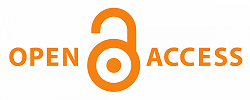DESCRIPTION OF BLOOD GLUCOSE LEVELS IN OBESITY PATIENTS IN PUSKESMAS NORTH CITY
Abstract
Excess weight can cause changes to the body's cells, making the body's cells resistant to the hormone insulin. This can cause blood glucose levels to increase. This study aims to determine blood glucose levels in obese patients and the factors that influence them. This study aims to assess blood glucose levels in obese patients at the North City Health Center and the factors that affect them.
The method in this study uses a descriptive quantitative approach. The type of data used is primary data from research results of blood glucose levels in obese patients and secondary data in data from the literature, books, questionnaires, and medical record books. The sampling technique in this study used accidental sampling, with a total sample of 29 people.
The results showed that from 29 obese patients, there were 24 people or 82.8% whose blood glucose levels were abnormal, while five people, or 17.2%, had normal blood glucose levels. Factors that affect blood glucose levels in obese patients are gender, age, physical pattern (Body Mass Index/BMI), physical activity, and eating patterns (number of calories). Suggestions to the next researcher are suggested to examine blood sugar levels between the obese and non-obese groups as a comparison.
References
[2] Almatsier, S (2009) Prinsip Dasar Ilmu Gizi. Jakarta: PT. Gramedia Pustaka Utama.
[3] Anofi .A., Widaastuti.W, Nurwiyeni. (2018) Gambaran Gula Darah Mahasiswa YangObesitas di Fakultas Kedokteran Universitas Baiturrahmah Tahun 2017.
[4] Arisman, M. B. (2010). Obesitas, Diabetes Melitus dan Dislipidemia, Buku Ajar Ilmu Gizi. EGC. Jakarta.
[5] Budiman, Hendra. 2010. Asam lemak omega-3 dan kesehatan jantung. MajalahKedokteran. 2010;8(1). Diakses pada 31 Juli 2021.
[6] Hutagaol, H. (2014). Pengaruh Gaya Hidup terhadap Kejadian Diabetes Melitus Tipe 2 di Rumah Sakit Umum Daerah Kota Padangsidimpuan Tahun 2014 IDF. 2014. IDF Diabetes Atlas Sixth Edition. http://www.idf.org. Diakses pada tanggal 23 Mei 2021.
[7] Henderson, KE, Baranski RJ, Bickel PE, Clutter WE, McGill JB (2009), Subspecialty Consult Series Endocrinology Subspecialty Consult, 2and Edition Philadelphia: Lippincott Williams and Wilkins, USA, pp. 202-205.
[8] Janghorbani, M., Amini, M., Willett, W.C., Mehdi Gouya, M., Delavari, A., Alikhani, S. & Mahdavi, A. (2007). First Nationwide Survey of Prevalence of Overweight, Underweight, and Abdominal Obesity in Iranian Adults, Obesity , 15(11): 2797-2808. Diakses pada 01 Agustus 2021.
[9] Kementrian Kesehatan Republik Indonesia, (2012). Pedoman Pencegahan dan Penggulangan Kegemukan dan Obesitas Pada Anak Sekolah
[10] Kementrian Kesehatan Republik Indonesia, (2017). Integrasi Seluruh Komponen Bangsa Mewujudkan Indonesia Sehat. Bakti Husada
[11] Kementrian Kesehatan Republik Indonesia, (2019). Kit Informasi : Epidemi Obesitas. Kementerian Kesehatan RI. Jakarta.
[12] Kementrian Kesehatan Republik Indonesia, (2020). Profil Kesehatan Indonesia Tahun 2019. Kementerian Kesehatan RI. Jakarta.
[13] Kurniawan, I. (2014) Hubungan antara Indeks Massa Tubuh dengan Kadar Gula Darah Postprandial pada Anggota Kepolisian Resor Karanganyar. Skripsi. Surakarta: Universitas Muhammadiyah Surakarta.
[14] Listiyana, A.D., Mardiana. & Prameswari, G.N. (2013). Obesitas Sentral dan Kadar Kolesterol Darah Total. Jurnal Kesehatan Masyarakat, 9(1): 37-43. Diakses pada 03 Agustus 2
Copyright (c) 2020 rayhan tantu, Titin Dunggio, Niluh Arwati

This work is licensed under a Creative Commons Attribution 4.0 International License.












